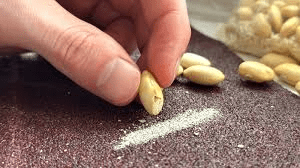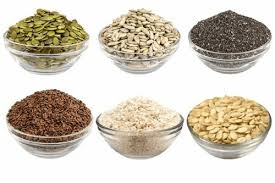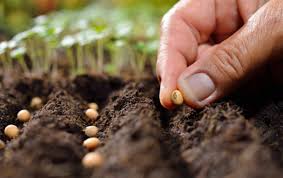Seeds and other planting materials are the basic foundation upon which successful crop production is laid. Failure in the crop production enterprise could result from errors in seed selection, seed storage, planting time, planting depth, seeding rate, and spacing.
All aspects of seed sowing, planting practices, and materials are covered in this unit, including quality, germinations, seed storage, seed treatments, time of planting, seed rate, depth of planting, seed placement, seed emergence, and seedling vigor.
1. Definition
The establishment of field crops could either be from seeds or vegetative parts. The term sowing refers to seeds while planting is used when vegetative parts are involved.
The following are examples of crops established by sowing seeds: maize, groundnuts, sorghum, millet, wheat, cowpeas, and mellon.
Planting vegetative parts are typically used to establish crops such as yams, sugarcane, ginger, sisal, cocoyam, sweet potatoes, and cassava.
A seed consists of miniature plants (the embryo) enclosed in a wrapper (the testa) sometimes many nutritive materials (the endosperm) may also be enclosed in the wrapper. The embryo represents the new generation of the plants and it is the most essential part of the seed.
It is made up of three parts: a shoot axis (the plumule), a root axis (the radicle), and one or more seed leaves (the cotyledons).
The cotyledons store a large portion of the food materials in seeds that lack an endosperm.
The testa is the seed’s outer covering, except for a small pore, it usually completely encloses the seed.
Read Also: Advantages of Inter-cropping a Plantain Field
2. Germination of Seeds

The process of germination involves the growth of the miniature plants (embryo) contained within the seed into a larger plant.
The primary function of endosperm, if present, is to supply food materials to the developing embryo.
The first thing that happens after a seed is planted in moist soil is that the seed absorbs water.
The process causes the seed to swell and also results in the activation of various enzymes systems in the seed. Following the intake of water, the food material present in the seed is hydrolyzed.
The products of the hydrolysis are then translocated to the growing points, where they are used as a building block for new cells and as substrates for respiration to supply energy for various processes.
i. Conditions necessary for germination
For seeds to germinate certain environmental conditions must be fulfilled:
- Water must be available so that when it is imbibed by the seed, metabolic processes within the seeds are enhanced.
- Oxygen should be present for aerobic respiration to occur to supply energy for the germination process.
- Thirdly, ensure that there’s an appropriate temperature.
ii. Types of germination
The morphological changes that occur during germination vary greatly between seeds.
The cotyledons are carried above ground level in some cases due to elongation of the region just below the cotyledons (hypocotyl).
Seedlings that germinate in this manner are known as epigeal germination.
The seedlings of groundnuts, melon, cowpea, onion, okra and castor are all epigeal. In contrast to epigeal seedlings, cotyledons remain at the level where the seed was planted and are not transported above ground.
Such seedlings exhibit hypogeal germination. Rice, maize, guinea corn, rubber, and broad beans seedlings are all examples of hypogeal germination.
Read Also: Complete List and Importance of Chemical Fertilizers for Crops
3. Seed Dormancy

When a living seed fails to germinate even when provided with the normal conditions necessary for germination, such a seed is said to be dormant.
i. Causes of seed dormancy
- Presence of an impermeable testa that may prevent intakes of water and probably oxygen or.
- The presence of growth inhibitors in the seed.
- It could also be caused by the need for cold treatment or exposure to specific photoperiods before the seed can germinate.
- At the time of harvest, the embryo is still immature and has not reached full development.
- Very high temperature during seed maturity may induce dormancy in some species.
ii. Measures of overcoming seed dormancy
a. After ripening treatment
One type of primary dormancy is characterized by immature embryos. Although the plant sheds the seeds, the embryo must continue to develop before germination can occur.
The problem of immature embryos will be overcome if the seed receives appropriate after-ripening treatment. After-ripening of certain palm seeds often necessitates high temperatures of 38°C to 40°C for three months.
b. Stratification
Seeds of many plants require moist chilling conditions for some time to render them capable of germination. This process is called stratification. Chilling is usually 0°c- 10°c for 7 to 180 days. For example, apple seeds require up to 60 days in a moist medium at 3°c to 5°c to overcome dormancy.
c. Scarification
Some plant species’ seeds have a very hard covering that, if not treated, may prevent them from germinating.
A hard seed coat can prevent water absorption and gas exchange, or it can physically prevent the embryo from growing and emerging through the seed coat.
It is, therefore, necessary to make these covering weaker or previous to water and gasses through the process of scarification.
d. Light
Is essential for seed germination of certain species of lettuce (Positively photoelastic) If the light is required seed should be sown shallowly.
Some species such as tomatoes and some lilies are negatively photoblastic (their germination is inhibited by light) and should be sown more deeply for good germination.
Read Also: Brooder Guards and It’s Uses in Poultry Farming
e. Vernalization of seeds
The temperature has an impact on the timing of flowering in many plants.
Winter cereal crops head normally from a spring sowing and behave similarly to spring varieties when the seeds are germinated at temperatures slightly above freezing before being sown. This is known as vernalization.
iii. Method of seed scarifications

a. Seeds can be scarified by soaking them in concentrated sulphuric acid for a period ranging from a few minutes to an hour or more.
b. A hot water soak is another method of scarifying seeds, first heating water to boiling point adding seeds, and removing them when the water is cold 12- 24 hours later.
c. Dry heat can be used to rupture the seed coat of some species.
d. Mechanical scarifier can be used to scratch the seed coats. When scarified seeds deteriorate rapidly, they should be planted immediately.
e. In dry storage, aging causes a slow natural deterioration of the seed coat.
In an alfalfa experiment, half of the impermeable seeds germinated after one and a half years, while all germinated after eleven years.
f. Alternate freezing and thawing sometimes stimulate germination of hard seeds of alfalfa and sweet clover.
The germination of hard seeds of alfalfa or clover can also be achieved by exposure for 1-1.5 seconds or less to infrared rays of 1180 millimicrons wavelength or by exposure to a few seconds of high-frequency electric energy.
Read Also: Sowing Guide for Different Kind of Crops
4. Seed Quality
The factors affecting seed quality
Factors affecting seed quality include the following: maturity, wholesomeness, disease and pests, and foreign matters.
a. Maturity
Immature seeds store poorly and, in many cases, do not germinate.
Both the stage of maturity when harvested and the conditions prevailing during maturity are important factors in seed quality.
b. Wholesomeness
Germination would be reduced if the seed was injured, cracked, or broken.
The extent to which a seed’s ability to germinate is hampered is determined by the part of the seed that has been injured.
Large amounts of injury in the endosperm or at the edges of the cotyledons may only slightly impair germination, whereas minute injury to the plumule-radicle axis may also make them susceptible to disease and pest, reducing their storability.
Broken but otherwise good seed has a lower market value than whole seeds.
Thus, whether or not seeds are to be sown, their wholesomeness is important.
c. Disease and Pest
The presence of diseases and pest reduce the quality of seeds both for consumption and for sowing.
Diseases impact an unpleasant odor and taste to the seed, while pests may consume the seeds and degrade them with excrement.
Diseased seeds germinate poorly and pests such as cowpea weevil may damage the seeds and also cause poor germination.
Seeds that are to be stored are commonly protected from disease and pests by treating them with appropriate pesticides. This process is known as seed dressing.
d. Foreign matter
The presence of foreign matter in the seed lot reduces the quality of the seed lot.
Inert foreign matters such as stone and dried plant material are objectionable, particularly in seeds destined for consumption.
Even more objectionable are weed seeds which may pose grave problems when the seeds are sown.
Moreover, weed seeds may promote spoilage of seed lot during storage.
5. Seed Certification
In each country in Africa, there is an agency responsible for overseeing and supervising the quality of seeds.
In Nigeria that responsibility lies with the national seed service. The national seed service has to certify seed that is intended for sowing, using most of the quality criteria discussed earlier in this unit.
The agency’s activities include monitoring seed production sites, grading seeds, performing viability and germination tests, certifying seeds, and, in some cases, distributing certified seeds.
Read Also: 16 Hidden Health Benefits of Tomato Seeds
Classes of Seeds

a. Breeder seeds
This provides the source of the initial and recurring increase of foundation seed.
They are controlled directly by the originator or, in some cases, by the sponsoring plant breeder or institution.
b. Foundation seeds
All other certified seed classes are derived from foundation seed, either directly or indirectly through registered seed.
They are handled to maintain specific genetic identity and purity as prescribed by the agricultural experimental station.
c. Registered seeds
These are the progeny of foundation or registered seed.
It is carefully handled to maintain satisfactory genetic identity and purity that has been approved and certified by the certifying agency.
This class of seed should be of a quality suitable for the production of certified seed.
d. Certified seeds
This shall be the progeny of foundation, registered or certified seed that is so handled as to maintain satisfactory genetic identity and purity.
Such seeds have been approved and certified by the certifying agency.
6. Seed Storage
The optimum conditions for storing seeds that would endure long term storage are:
a. Drying the seed to 5- 7 percent moisture content.
b. Sealed storage in the absence of oxygen.
c. A Storage temperature of 7.5° to 15°c.
Most seed stores are well in cool dry condition. However, some seeds may lose viability rapidly when dry.
Within limits, for most species, for each 10 percent decrease in seed moisture, the life of the seed is doubled.
Likewise the life of the seed doubles for each 10°c drop in temperatures. Most seeds can be stored at 18°c for a considerable length of time.
Seeds of some plants including citrus and chestnut should be stored moist under refrigerated conditions. A moist chilling condition is required.
To stratify seeds of many woody temperate spices, which aids in their dormancy.
Most seeds should be kept dry in a tightly sealed container if stored in small quantities.
Read Also: Complete List and Importance of Chemical Fertilizers for Crops
7. Seed Treatments before Sowing
Both insects and diseases may be seed-borne. Disease and pest control through seed treatment is sometimes required.
Methods of Seed Treatments
a. Surface treatment
Some seed-borne diseases are caused by organisms that live on the surface of the seed and can be controlled chemically, such as the damping-off of seedlings.
Seeds treatment may also protect young seedlings from soil-borne diseases at the time of germination when they are especially vulnerable.
Copper sulfate, formaldehyde, and oxide are among the chemical commonly used.
b. Hot water treatment
When the disease-causing organism is found beneath the seed coat, surface application of chemicals may not be effective.
Some of these seeds may be treated with hot water for some time sufficient to kill the disease without destroying the viability of the seeds.
c. Fumigation
Weevils in beans may be controlled by fumigation with formaldehyde.
When the seed is not treated, the weevils may develop within the seeds and render them incapable of germination.
d. Pelleted seeds
Even distribution of very small irregular seeds is often a problem.
A pelleting procedure has been developed whereby individual seeds are coated with a material that may contain a fungicide and a chemical to stimulate growth and enclose the seed in spheres of uniform size.
Pelleted seeds are much more easily sown at regular intervals and may produce a better result.
Related: Comprehensive Guide on How to start Cockerel Farming Business
Frequently Asked Questions
We will update this section soon.

